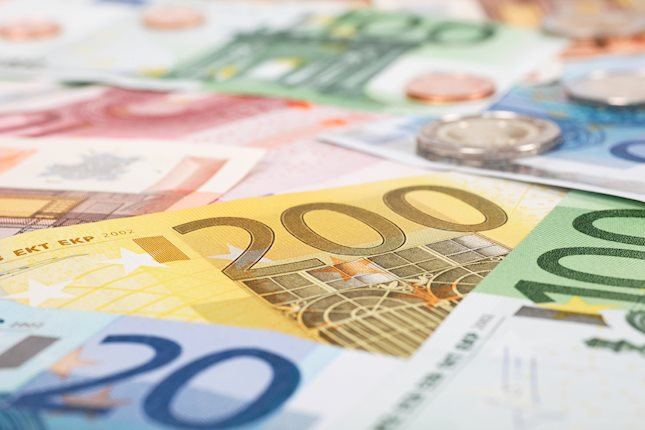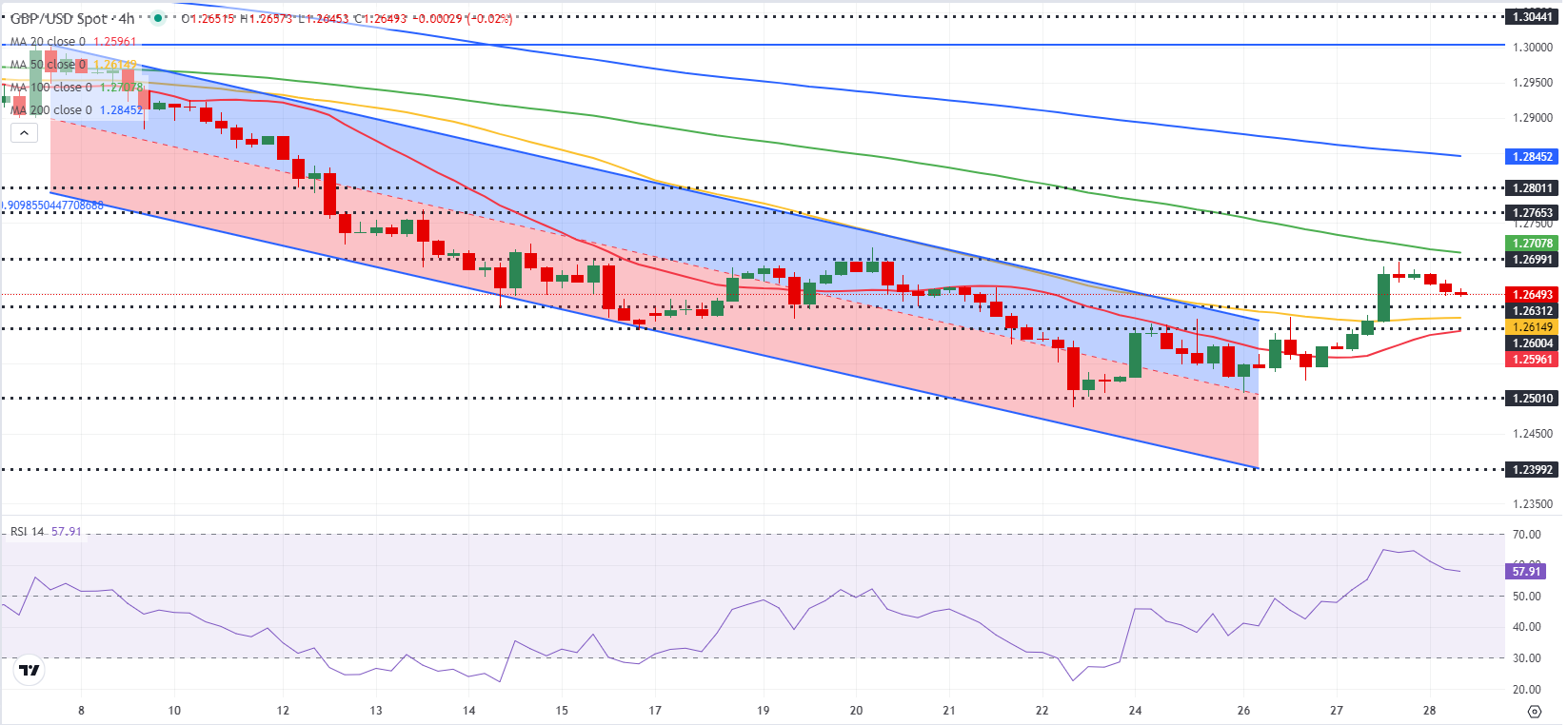- GBP/USD struggles to build on Wednesday's strong gains.
- The near-term technical outlook suggests that the bullish bias remains intact.
- The pair needs to clear 1.2700 to continue to push higher.
Following the choppy action seen earlier in the week, GBP/USD turned north and gained nearly 0.9% on the day on Wednesday. The pair corrects lower early Thursday and trades at around 1.2650.
British Pound PRICE This week
The table below shows the percentage change of British Pound (GBP) against listed major currencies this week. British Pound was the weakest against the Japanese Yen.
| USD | EUR | GBP | JPY | CAD | AUD | NZD | CHF | |
|---|---|---|---|---|---|---|---|---|
| USD | -1.08% | -0.95% | -1.47% | 0.49% | 0.33% | -0.50% | -0.84% | |
| EUR | 1.08% | -0.04% | -1.02% | 0.99% | 1.35% | 0.00% | -0.34% | |
| GBP | 0.95% | 0.04% | -0.98% | 1.03% | 1.39% | 0.04% | -0.30% | |
| JPY | 1.47% | 1.02% | 0.98% | 2.01% | 2.28% | 1.07% | 0.85% | |
| CAD | -0.49% | -0.99% | -1.03% | -2.01% | -0.01% | -0.97% | -1.35% | |
| AUD | -0.33% | -1.35% | -1.39% | -2.28% | 0.00% | -1.32% | -1.66% | |
| NZD | 0.50% | -0.01% | -0.04% | -1.07% | 0.97% | 1.32% | -0.35% | |
| CHF | 0.84% | 0.34% | 0.30% | -0.85% | 1.35% | 1.66% | 0.35% |
The heat map shows percentage changes of major currencies against each other. The base currency is picked from the left column, while the quote currency is picked from the top row. For example, if you pick the British Pound from the left column and move along the horizontal line to the US Dollar, the percentage change displayed in the box will represent GBP (base)/USD (quote).
The US Dollar came under selling pressure in the American session on Wednesday as markets reacted to mixed macroeconomic data releases. Additionally, month-end flows may have been triggered ahead of the Thanksgiving Day holiday in the US, further weighing on the currency.
The US Census Bureau reported that Durable Goods Orders increased by 0.2% on a monthly basis in October, missing the market expectation of 0.5%. The Department of Labor announced that Initial Jobless Claims declined to 213,000 in the week ending November 23 from 215,000 in the previous week. Finally, the Personal Consumption Expenditures (PCE) Price Index, the Federal Reserve's (Fed) preferred gauge of inflation, rose 2.3% on a yearly basis, up from 2.1% in September and in line with the market consensus, while the annual core PCE inflation edged higher to 2.8% from 2.7%.
In the second half of the day, the trading action in foreign exchange markets is likely to remain subdued amid a lack of volume on the Thanksgiving Day. Financial markets in the US will open at the regular time on Friday but they will close early.
In the European session on Friday, the Bank of England will publish the Financial Stability Report.
GBP/USD Technical Analysis
GBP/USD rose above the upper limit of the descending regression channel and closed the last five 4-hour candles above the 50-period Simple Moving Average (SMA). Additionally, the Relative Strength Index (RSI) indicator stays near 60, confirming the bullish bias.
On the upside, the 100-period SMA forms key resistance at 1.2700. If GBP/USD rises above this level and starts using it as support, it could face next resistance at 1.2760 (static level) before 1.2800 (static level, round level). Looking south, first support area could be spotted at 1.2610-1.2600 (50-period SMA, round level, 20-period SMA) ahead of 1.2500 (static level, round level).
Pound Sterling FAQs
The Pound Sterling (GBP) is the oldest currency in the world (886 AD) and the official currency of the United Kingdom. It is the fourth most traded unit for foreign exchange (FX) in the world, accounting for 12% of all transactions, averaging $630 billion a day, according to 2022 data. Its key trading pairs are GBP/USD, also known as ‘Cable’, which accounts for 11% of FX, GBP/JPY, or the ‘Dragon’ as it is known by traders (3%), and EUR/GBP (2%). The Pound Sterling is issued by the Bank of England (BoE).
The single most important factor influencing the value of the Pound Sterling is monetary policy decided by the Bank of England. The BoE bases its decisions on whether it has achieved its primary goal of “price stability” – a steady inflation rate of around 2%. Its primary tool for achieving this is the adjustment of interest rates. When inflation is too high, the BoE will try to rein it in by raising interest rates, making it more expensive for people and businesses to access credit. This is generally positive for GBP, as higher interest rates make the UK a more attractive place for global investors to park their money. When inflation falls too low it is a sign economic growth is slowing. In this scenario, the BoE will consider lowering interest rates to cheapen credit so businesses will borrow more to invest in growth-generating projects.
Data releases gauge the health of the economy and can impact the value of the Pound Sterling. Indicators such as GDP, Manufacturing and Services PMIs, and employment can all influence the direction of the GBP. A strong economy is good for Sterling. Not only does it attract more foreign investment but it may encourage the BoE to put up interest rates, which will directly strengthen GBP. Otherwise, if economic data is weak, the Pound Sterling is likely to fall.
Another significant data release for the Pound Sterling is the Trade Balance. This indicator measures the difference between what a country earns from its exports and what it spends on imports over a given period. If a country produces highly sought-after exports, its currency will benefit purely from the extra demand created from foreign buyers seeking to purchase these goods. Therefore, a positive net Trade Balance strengthens a currency and vice versa for a negative balance.
Information on these pages contains forward-looking statements that involve risks and uncertainties. Markets and instruments profiled on this page are for informational purposes only and should not in any way come across as a recommendation to buy or sell in these assets. You should do your own thorough research before making any investment decisions. FXStreet does not in any way guarantee that this information is free from mistakes, errors, or material misstatements. It also does not guarantee that this information is of a timely nature. Investing in Open Markets involves a great deal of risk, including the loss of all or a portion of your investment, as well as emotional distress. All risks, losses and costs associated with investing, including total loss of principal, are your responsibility. The views and opinions expressed in this article are those of the authors and do not necessarily reflect the official policy or position of FXStreet nor its advertisers. The author will not be held responsible for information that is found at the end of links posted on this page.
If not otherwise explicitly mentioned in the body of the article, at the time of writing, the author has no position in any stock mentioned in this article and no business relationship with any company mentioned. The author has not received compensation for writing this article, other than from FXStreet.
FXStreet and the author do not provide personalized recommendations. The author makes no representations as to the accuracy, completeness, or suitability of this information. FXStreet and the author will not be liable for any errors, omissions or any losses, injuries or damages arising from this information and its display or use. Errors and omissions excepted.
The author and FXStreet are not registered investment advisors and nothing in this article is intended to be investment advice.
Recommended Content
Editors’ Picks

EUR/USD stays below 1.0550 after soft German inflation data
EUR/USD trades in negative territory slightly below 1.0550 on Thursday. Soft inflation data from Germany makes it difficult for the Euro to gather strength, causing the pair to stretch lower. US markets will remain closed in observance of the Thanksgiving Day holiday.

GBP/USD trades below 1.2700 on modest USD recovery
GBP/USD stays under modest bearish pressure and fluctuates below 1.2700 on Thursday. The US Dollar corrects higher following Wednesday's sharp decline, not allowing the pair to gain traction. The market action is likely to remain subdued in the American session.

Gold clings to small daily gains near $2,650
Gold (XAU/USD) reverses an intraday dip to the $2,620 area and trades near $2,650 on Thursday, albeit it lacks bullish conviction. Investors remain concerned that US President-elect Donald Trump's tariff plans will impact the global economic outlook.

Fantom bulls eye yearly high as BTC rebounds
Fantom (FTM) continued its rally and rallied 8% until Thursday, trading above $1.09 after 43% gains in the previous week. Like FTM, most altcoins have continued the rally as Bitcoin (BTC) recovers from its recent pullback this week.

Eurozone PMI sounds the alarm about growth once more
The composite PMI dropped from 50 to 48.1, once more stressing growth concerns for the eurozone. Hard data has actually come in better than expected recently – so ahead of the December meeting, the ECB has to figure out whether this is the PMI crying wolf or whether it should take this signal seriously. We think it’s the latter.

Best Forex Brokers with Low Spreads
VERIFIED Low spreads are crucial for reducing trading costs. Explore top Forex brokers offering competitive spreads and high leverage. Compare options for EUR/USD, GBP/USD, USD/JPY, and Gold.
